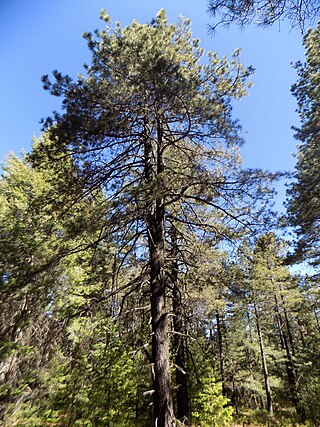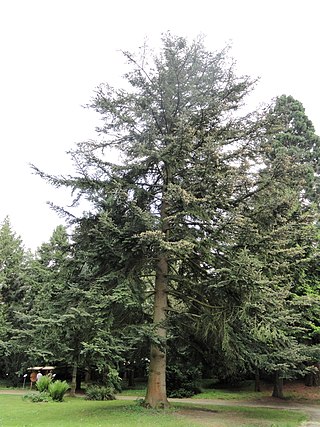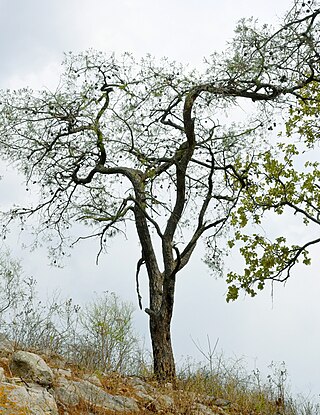
Pinus peuce is a species of pine native to the mountains of North Macedonia, Bulgaria, Albania, Montenegro, Kosovo, the extreme southwest of Serbia, and the extreme north of Greece, growing typically at (600-) 1,000-2,200 (-2,300) m altitude. It often reaches the alpine tree line in this area. The mature size is up to 35–40 m height, and 1.5 m trunk diameter. However, the height of the tree diminishes strongly near the upper tree line and may even obtain shrub sizes.

Pinus densiflora, also called the Japanese red pine, the Japanese pine, or Korean red pine, is a species of pine tree native to East Asia. In China it is known as 赤松.

Pinus clausa is a species of pine endemic to the Southeastern United States. Its common names include sand pine, Florida spruce pine, Alabama pine, and scrub pine.

Pinus muricata, the bishop pine, is a pine with a very restricted range: mostly in California, including several offshore Channel Islands, and a few locations in Baja California, Mexico. It is always on or near the coast.

Pinus arizonica, commonly known as the Arizona pine, is a medium-sized pine in northern Mexico, southeast Arizona, southwest New Mexico, and western Texas in the United States. It is a tree growing to 25–35 m tall, with a trunk diameter of up to 1.2 m. The needles are in bundles of 3, 4, or 5, with 5-needle fascicles being the most prevalent. This variability may be a sign of hybridization with the closely related ponderosa pine. The cones are single, paired, or in whorls of three, and 5–11 cm long.

Pinus thunbergii, the black pine, Japanese black pine, or Japanese pine, is a pine tree native to coastal areas of Japan and South Korea.

Pinus armandii, the Armand pine or Chinese white pine, is a species of pine native to China, occurring from southern Shanxi west to southern Gansu and south to Yunnan, with outlying populations in Anhui. It grows at altitudes of 2200–3000 m in Taiwan, and it also extends a short distance into northern Burma. In Chinese it is known as "Mount Hua pine" (华山松).

Juniperus squamata, the flaky juniper, or Himalayan juniper is a species of coniferous shrub in the cypress family Cupressaceae, native to the Himalayas and China.

Larix griffithii, the Sikkim larch, is a species of larch, native to the eastern Himalaya in eastern Nepal, Sikkim, western Bhutan and southwestern China, growing at 1,800–4,100 metres (5,900–13,500 ft) in altitude.

Pinus durangensis, the Durango pine, is a pine tree species endemic to the Sierra Madre Occidental mountain range of north-western Mexico.

Picea schrenkiana, Schrenk's spruce, or Asian spruce, is a spruce native to the Tian Shan mountains of Central Asia and also to western China (Xinjiang). It grows at elevations of 1,200–3,500 m (3,900–11,500 ft), usually in pure forests, sometimes mixed with the Tien Shan variety of Siberian fir. Its name was given in honour of Alexander von Schrenk (1816–1876).

The Caribbean pine is a hard pine species native to Central America and the northern West Indies. It belongs to subsection Australes in subgenus Pinus. It inhabits tropical and subtropical coniferous forests such as Bahamian pineyards, in both lowland savannas and montane forests.

Pinus massoniana is a species of pine, native to Taiwan, a wide area of central and southern China, and northern Vietnam.

Abies delavayi, the Delavay's silver-fir or Delavay's fir, is a species of fir, native to Yunnan in southwest China and adjoining border areas in southeastern Tibet, far northeastern India, northern Myanmar, and far northwestern Vietnam. It is a high altitude mountain tree, growing at elevations of 3,000–4,000 m, often occupying the tree line.

Calocedrus formosana is a conifer endemic to Taiwan.

Abies chensiensis, the Shensi fir, is a fir native to Gansu, Hubei, Sichuan, Tibet, Yunnan in China, and Arunachal Pradesh in India. It was first described by Philippe Édouard Léon Van Tieghem in 1892.

Larix potaninii is a species of larch conifer in the family Pinaceae. It is found in China and Nepal. The one of southernmost species of the genus Larix, the range of Larix potaninii extends southward almost to 27° N.

Pinus praetermissa, commonly known as McVaugh's pine, is a species of conifer in the family Pinaceae. Originally classified as a variety of Pinus oocarpa in 1909, it was promoted to specific status in 1990 after further study.

Pinus pseudostrobus, known in English as the smooth-bark Mexican pine and in Spanish as chamite or pacingo, is a tree found in forests of Mexico and Central America. It is 8 to 25 m tall with a dense and round top.It is threatened by logging and wood harvesting. The bark is brown and fissured and smooth when young. It is subject to ex-situ conservation. It grows at altitudes between 850 and 3250 m. from 26° to 15° north latitude, from Sinaloa, Mexico to Nicaragua and Honduras. It occurs within a rainfall regime that rains mostly in summer.

Pinus armandii var. mastersiana, also known by the common names of the Taiwan high mountain pine, Taiwan mountain pine, or Masters' pine, is a rare variety of Pinus armandii in the family Pinaceae that is endemic to portions of northern and central Taiwan.




















